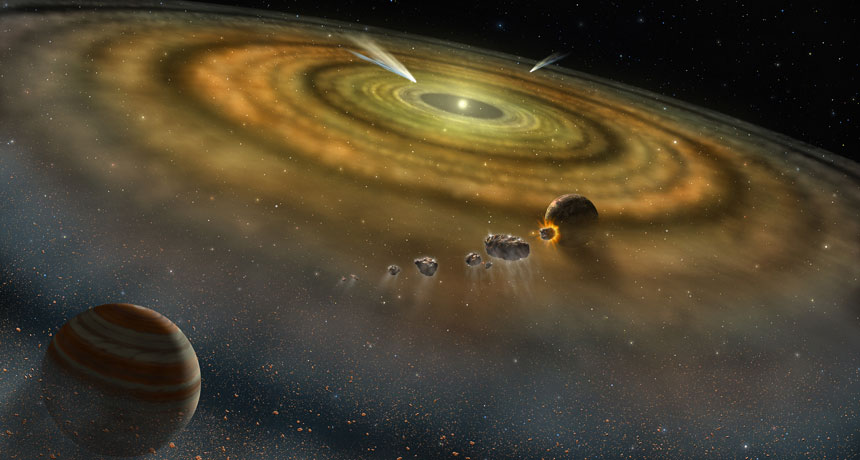Moons that escape their planets could become ‘ploonets’
Current telescopes may be able to find the wandering worlds

THAT’S NO MOON Comets around distant stars, shown in this artist’s illustration, could be explained by “ploonets” — moons that were freed from their orbits around migrating gas giants.
LYNNETTE COOK/Fuse/NASA
- More than 2 years ago
Meet ploonets: planets of moonish origin.
In other star systems, some moons could escape their planets and start orbiting their stars instead, new simulations suggest. Scientists have dubbed such liberated worlds “ploonets,” and say that current telescopes may be able to find the wayward objects.
Astronomers think that exomoons — moons orbiting planets that orbit stars other than the sun — should be common, but efforts to find them have turned up empty so far (SN Online: 4/30/19). Astrophysicist Mario Sucerquia of the University of Antioquia in Medellín, Colombia and colleagues simulated what would happen to those moons if they orbited hot Jupiters, gas giants that lie scorchingly close to their stars (SN: 7/8/17, p. 4). Many astronomers think that hot Jupiters weren’t born so close, but instead migrated toward their star from a more distant orbit.
As the gas giant migrates, the combined gravitational forces of the planet and the star would inject extra energy into the moon’s orbit, pushing the moon farther and farther from its planet until eventually it escapes, the researchers report June 27 at arXiv.org.
“This process should happen in every planetary system composed of a giant planet in a very close-in orbit,” Sucerquia says. “So ploonets should be very frequent.”
Some ploonets may be indistinguishable from ordinary planets. Others, whose orbits keep them close to their planet, could reveal their presence by changing the timing of when their neighbor planet crosses, or transits, in front of the star. The ploonet should stay close enough to the planet that its gravity can speed or slow the planet’s transit times. Those deviations should be detectable by combining data from planet-hunting telescopes like NASA’s TESS or the now-defunct Kepler, Sucerquia says.
Ploonethood may be a relatively short-lived phenomenon, though, making the worlds more difficult to spot. About half of the ploonets in the researchers’ simulations crashed into either their planet or star within about half a million years. And half of the remaining survivors crashed within a million years.
Even with few visible survivors, ploonets could help explain some bizarre exoplanetary features. Moon debris from such crashes could lead to giant ring systems around planets, like the 37 rings that encircle exoplanet J1407b, the team says.
Or, if the ploonet had an icy surface or an atmosphere before moving close to its star, the star’s heat would evaporate it, giving the ploonet a tail like a comet’s. Evaporating ploonets zipping by with a long light-blocking tail could explain strangely flickering stars like Tabby’s star, Sucerquia says (SN: 12/22/18, p. 9).
“Those structures [rings and flickers] have been discovered, have been observed,” Sucerquia says. “We just propose a natural mechanism to explain [them].”
While the solar system doesn’t have any hot Jupiters, ploonethood may be possible here, too. Earth’s moon is moving slowly away from the Earth, at a rate of about 4 centimeters per year. When it eventually breaks free, “the moon is a potential ploonet,” Sucerquia says — although that won’t happen for about 5 billion years.
The study is a good first step for thinking about what would happen to exomoons in real planetary systems, says planetary astrophysicist Natalie Hinkel of the Southwest Research Institute in San Antonio, who wasn’t involved in the new work. “Nobody’s looked at the problem quite like this,” she says. “It adds to the layers of how complex these systems are.”
Plus, ploonet is “a wonderful name,” Hinkel says. “Normally I sort of eye-roll at these made-up names, but this one is a keeper.”







